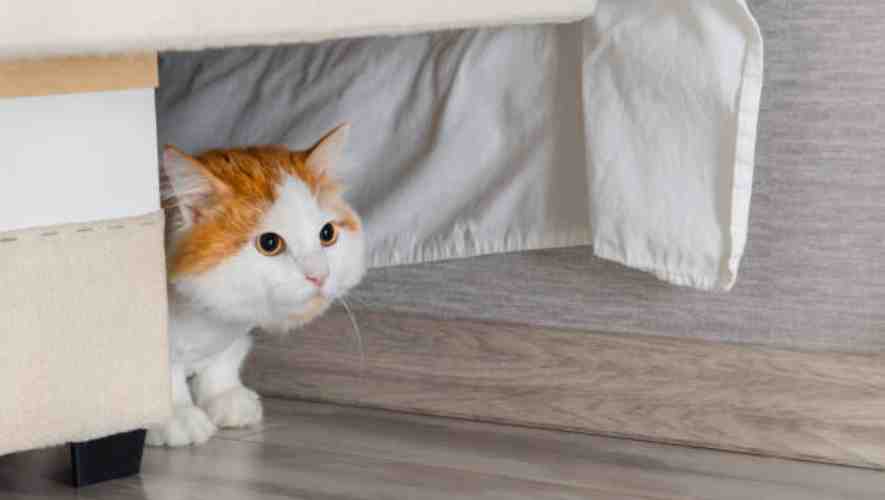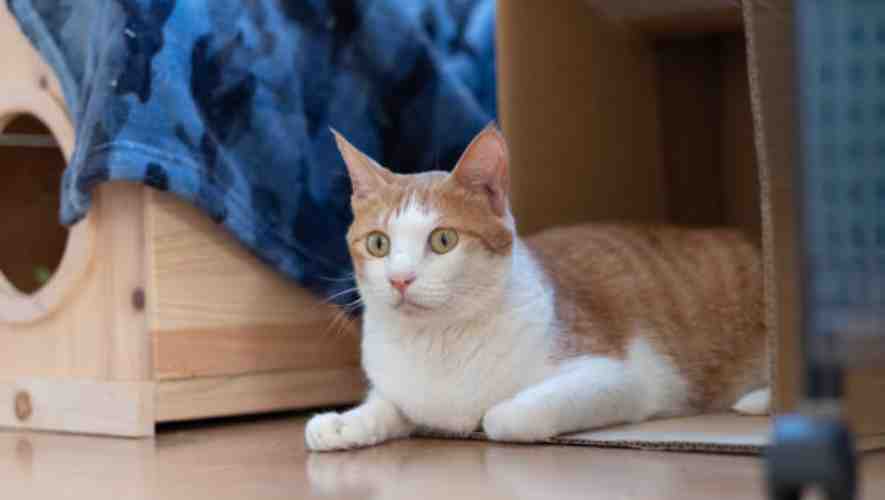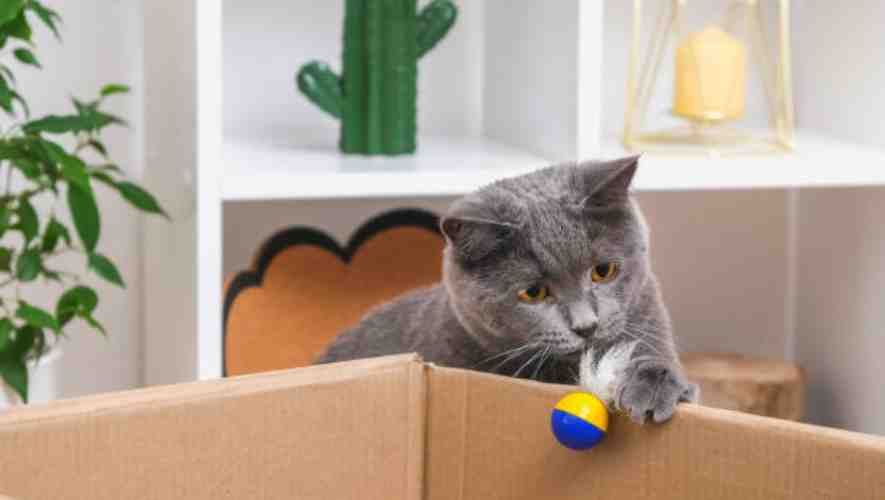Moving to a new home can be a stressful experience, not just for humans, but for our feline companions as well. You’re likely here because you’re concerned about how your cat might react to this significant change. Understanding the impact of moving on cats is crucial for any pet owner preparing for a relocation.
Do Cats Get Stressed When Moving? Yes, cats can get stressed when moving to a new environment. They are territorial animals and can find changes in their living situation unsettling. This stress can manifest through hiding, decreased appetite, or increased vocalization. Gradual acclimation to their new surroundings can help alleviate stress.
In this blog, we’ll dive into the intricacies of a cat’s mind during a move, exploring how changes in the environment affect them and what you can do to help. From recognizing signs of stress to providing comfort in new surroundings, we’ll cover all you need to know. If you’re looking to make your cat’s move as smooth and stress-free as possible, you’re in the right place.
Signs of Stress in Cats During Relocation

Physical Symptoms
Relocating can be a stressful experience for cats, often manifesting in noticeable physical symptoms. One common sign is a change in eating habits; a stressed cat may eat significantly more or less than usual.
Additionally, grooming behaviour often alters, with cats either neglecting grooming or over-grooming to the point of causing bald spots or skin irritation. These physical changes are crucial indicators of their discomfort and anxiety during the relocation process.
Behavioural Changes
Stress in cats due to relocation can also lead to profound behavioural changes. These may include increased hiding, as cats seek refuge in secluded areas to feel safe. On the other hand, some cats may display aggression, which is uncharacteristic of their normal behaviour.
Increased vocalisation is another sign, with cats meowing more frequently or loudly as an expression of their unease. These behavioural shifts are important cues that they are struggling to adapt to their new environment.
Emotional Indicators
Emotionally, cats under stress during relocation may exhibit a range of signs that reflect their internal state. A common indicator is increased clinginess; cats may become more attached to their owners, seeking constant companionship as a source of comfort.
Conversely, some cats might withdraw entirely, showing a noticeable decrease in interaction and affection. These emotional responses highlight their need for reassurance and stability amidst the changes surrounding them.
Factors Contributing to Stress in Cats When Moving

Disruption of Routine and Familiar Environment
Cats are creatures of habit and greatly value their routine and familiar environment. When moving, this sense of familiarity is disrupted, leading to significant stress.
The absence of their usual resting spots, feeding areas, and litter box locations can cause confusion and anxiety. This disruption extends beyond physical spaces; changes in daily routines, such as feeding and playtime schedules, can also contribute to a cat’s distress.
It’s crucial for cat owners to understand that their feline companions rely heavily on a predictable environment for a sense of security and comfort.
Sensitivity to Changes in Surroundings and New Scents
Cats possess a highly developed sense of smell, making them particularly sensitive to new scents in a different home. This sensitivity can trigger stress as they adjust to an unfamiliar environment. The presence of unfamiliar smells, such as those from previous occupants or new furniture, can be overwhelming and disorienting.
Additionally, the loss of their own scent markers, which cats use to identify their territory, can add to their discomfort. The introduction of these new sensory experiences is a significant factor in the stress experienced by cats during a move.
Travel-Related Stress (e.g., Car Rides, Carriers)
The physical act of moving, often involving car rides and carriers, can be a major source of stress for cats. Many cats are not accustomed to travel and may find the confinement of carriers and the movement and sounds of a vehicle distressing.
This discomfort can manifest as vocalisation, panting, or even aggressive behaviour. The unfamiliarity and restricted mobility in a carrier, coupled with the vibrations and noises of a vehicle, can create a high-stress environment for cats, exacerbating their overall anxiety during the moving process.
The Impact of the Owner’s Stress on the Cat
Cats are incredibly attuned to their owners’ emotions and can pick up on stress and anxiety. During a move, owners themselves are often stressed, and this emotional state can directly affect their pets.
Cats may become more anxious or agitated in response to their owner’s mood, leading to a heightened sense of stress.
It is important for cat owners to remain as calm and positive as possible during the moving process, as their demeanour can have a significant impact on their cat’s well-being and ability to adjust to the new environment.
Strategies to Mitigate Stress in Cats During Moving

Moving can be a stressful experience for cats, as it disrupts their familiar environment and routine. Understanding how to mitigate this stress is crucial for ensuring a smooth transition for your feline companion.
The following strategies, broken down into specific areas, provide a comprehensive approach to help your cat adjust to the moving process.
Preparation Techniques (e.g., Gradual Introduction to Carriers, Scent Familiarization)
Preparation is key in reducing stress for cats during a move. Begin by gradually introducing your cat to the carrier.
Place comfortable bedding inside and leave the carrier open in a familiar area, allowing your cat to explore it at their own pace. Additionally, scent familiarisation can be highly beneficial.
Cats rely heavily on scent for comfort, so placing familiar-smelling items inside the carrier and around the moving environment can help create a sense of security. This can include blankets, toys, or even a piece of your clothing.
Creating a Safe and Calm Environment During the Move
The actual moving day can be particularly unsettling for cats. To create a safe and calm environment, designate a quiet room in your current home for your cat to stay in while movers are present.
Ensure this room is equipped with your cat’s essentials, such as food, water, litter box, and familiar toys. When transporting your cat, cover the carrier with a light blanket to reduce visual stress.
Upon arrival, set up a similar safe space in the new home where your cat can adjust gradually to the new surroundings.
Tips for the Transition Period in the New Home
Once in the new home, it’s important to help your cat adjust during the transition period. Start by keeping your cat in a single room with their essentials, allowing them to become accustomed to the new smells and sounds.
Gradually introduce them to other areas of the house over several days or weeks, depending on their comfort level.Engage in regular play and interaction to help your cat associate the new environment with positive experiences.
Monitor their behaviour closely for signs of stress and provide extra comfort and reassurance as needed.
Importance of Maintaining Routine and Providing Familiar Objects
Maintaining a consistent routine is crucial in helping your cat adapt to a new environment. Stick to regular feeding, play, and cuddle times. This predictability provides a sense of security for your cat amidst the change. Additionally, surround your cat with familiar objects from the previous home.
These familiar items, whether it’s their favourite toy, bed, or scratching post, can significantly reduce anxiety and offer comfort during the transition. Being patient and providing a loving, reassuring presence will further support your cat’s adjustment to their new home.
Post-Move Adaptation and Long-term Considerations

Monitoring Cat Behavior and Health Post-Move
After relocating with your cat, it’s crucial to closely monitor their behaviour and health. Cats are sensitive to changes in their environment, and a move can be a significant stressor.
Observe your cat for signs of stress, such as hiding more than usual, changes in eating habits, or altered litter box usage. Also, look out for health issues like vomiting or diarrhoea, which could indicate that your cat is struggling to adapt.
Consistent observation helps in identifying any problems early, ensuring a smoother transition for your feline friend.
Long-Term Strategies for Stress Reduction and Acclimatisation
Ensuring your cat’s long-term comfort in their new environment involves a few key strategies. Firstly, maintain a consistent routine, as cats thrive on predictability. This includes regular feeding times, play sessions, and quiet time.
Secondly, create a safe and enriching environment with access to hiding spots, high perches, and scratching posts. Thirdly, consider pheromone diffusers or calming supplements, as recommended by a vet. These strategies collectively aid in reducing stress and helping your cat acclimatise to their new home.
When to Seek Veterinary Advice for Stress-Related Issues
It’s important to recognize when professional help is needed. If you notice persistent signs of stress, such as excessive grooming, aggression, or a marked change in appetite or behaviour, it’s time to consult a veterinarian.
These symptoms can indicate underlying health problems or severe anxiety. A veterinarian can offer tailored advice, which may include behavioural therapy, medication, or environmental modifications. Early intervention can prevent these issues from escalating, ensuring your cat’s well-being.
Summary of Key Points for Successful Relocation with a Cat
In summary, a successful relocation with a cat hinges on careful monitoring, stress reduction, and knowing when to seek professional help. Observe your cat’s behaviour and health closely post-move and employ strategies to create a stable, comforting environment.
Be vigilant for signs of stress or health issues, and don’t hesitate to consult a veterinarian if these arise. By taking these steps, you can greatly enhance your cat’s adaptation to their new home and ensure their long-term well-being.
Conclusion
Moving can be a stressful time for cats, as they are sensitive to changes in their environment. It’s essential to recognize signs of stress and take steps to help your cat adjust to the new home.
As we conclude this exploration of feline stress during moves, it’s clear that understanding and empathy are key. You, as a caring pet owner, can make a significant difference in how your cat copes with the transition. By preparing in advance, creating a safe space, and giving them time to adjust, you can help ease their anxiety. Remember, patience and love are your best tools. In the end, your cat will adapt to its new home, and your bond will likely grow stronger through this shared experience. Let this move be an opportunity to deepen the understanding and connection between you and your feline friend.
Frequently Asked Question(Do Cats Get Stressed When Moving)
How do you tell if your cat is stressed from moving?
To tell if your cat is stressed from moving, observe for hiding, decreased appetite, excessive vocalization, or changes in litter box habits. These signs indicate stress, requiring extra comfort and a quiet space to help your cat adjust to the new environment.
How do you calm a stressed cat after moving?
To calm a stressed cat after moving, create a quiet, safe space with familiar items like blankets and toys. Use pheromone diffusers to soothe them, maintain a routine for feeding and play, and offer lots of gentle affection and patience as they adjust.
Do cats get sad when they move?
Yes, cats can experience stress and sadness when they move to a new environment. Their strong territorial instincts make them sensitive to changes in their living space, often resulting in behaviors indicative of distress or adjustment challenges during the transition period.
How long does it take for a cat to get used to a new home?
It typically takes a cat one to two weeks to adjust to a new home, but some may require up to a month or more, depending on their personality and previous experiences.


